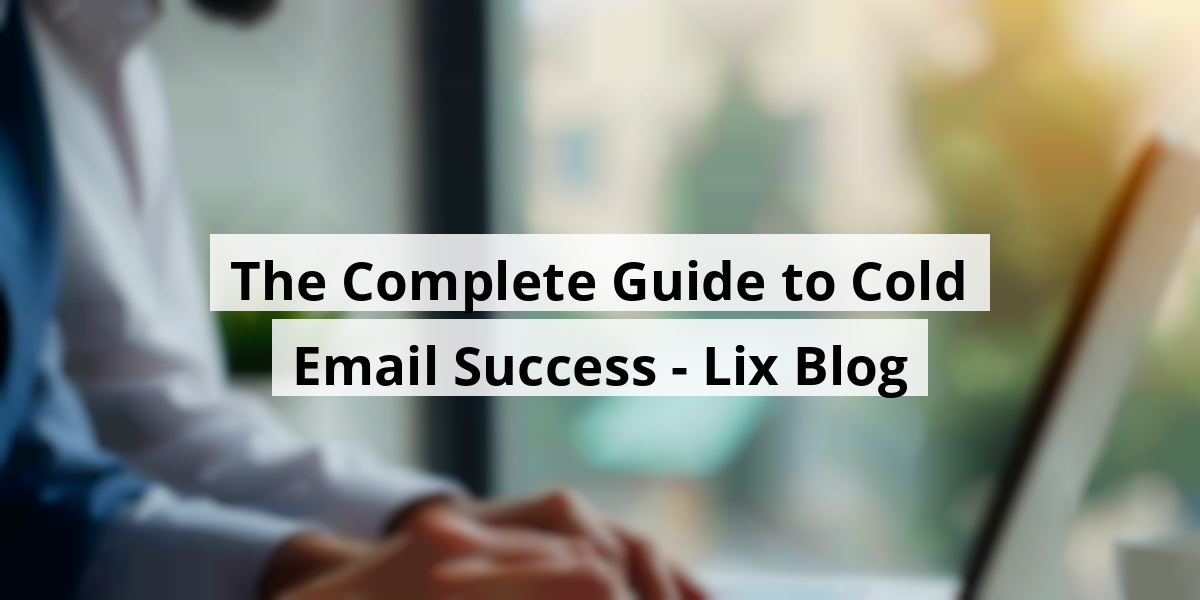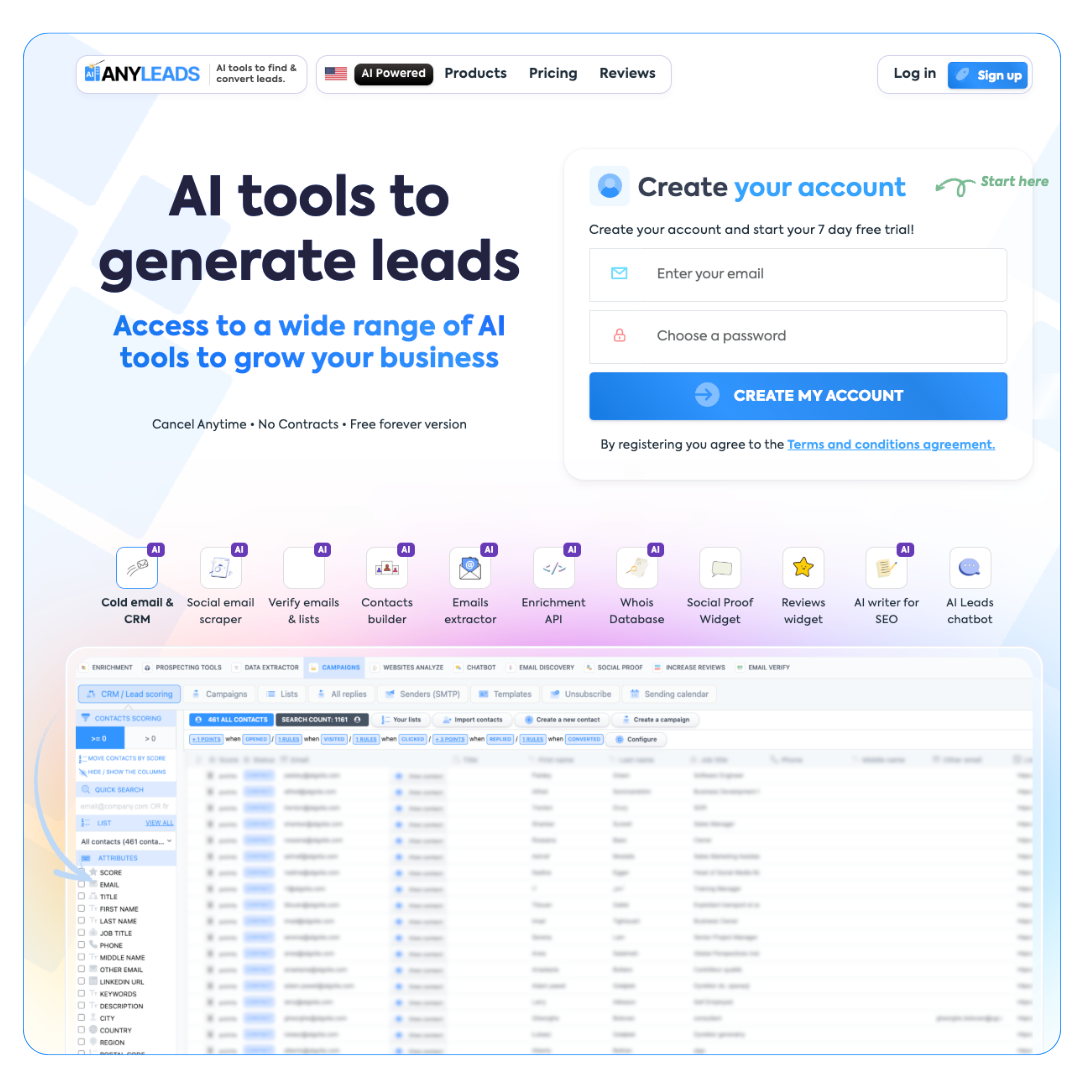 LIMITED SPOTS
All plans are 30% OFF for the first month! with the code WELCOME303
LIMITED SPOTS
All plans are 30% OFF for the first month! with the code WELCOME303

 LIMITED SPOTS
All plans are 30% OFF for the first month! with the code WELCOME303
LIMITED SPOTS
All plans are 30% OFF for the first month! with the code WELCOME303


Now we are going to talk about the essential elements that can make or break your cold email efforts. It’s like trying to bake a cake without flour; it just doesn’t work. Here’s where we find the fundamentals in cold emailing that will give us the best shot at getting noticed in that busy inbox.
Stay Concise
Did you know the average office worker is bombarded with 121 emails daily? Now, imagine being a decision-maker—it's like trying to drink from a fire hose! When they see a long email, they might as well be staring at a novel. We’ve all scrolled past those wall-of-text messages, haven’t we? So, why add to the clutter? A quick, snappy email gets straight to the point. It’s like serving a shot of espresso instead of a whole pot of coffee!
Make it Personal
We all love a little attention, right? When crafting emails, personalization can be your best friend. If you've only got a handful of targets, dive deep! Reference that fantastic article they penned, or a podcast episode where they dropped some wisdom bombs. But if you’re aiming for the masses, don’t stress—just group similar folks together. Tailor your message to their common experiences. Tossing in their name isn’t magic; relevance is!
Show Your Credibility
"Why should they listen to me?" you might wonder. That’s where credibility comes into play. Shout out past clients or projects that your prospect recognizes and respects. It’s a bit like name-dropping at a party—except this is business! Your audience wants to feel they’re in good hands. Mention any qualifications or industry insights to show you're someone worth listening to.
Highlight Benefits
Now, let’s get down to brass tacks. How can your proposal benefit them? Will it save them time or money? Your pitch should be about the results, not just the features of your service. Think of it like this: Apple didn’t just sell us a music player; they sold us the joy of being able to carry a concert in our pocket! Focus on their desired outcomes, and you’ll speak their language.
Include a Clear Request
Finally, what's the plan? Don’t leave your reader hanging! Whether you want them to book a call, reply with a simple question, or watch a video, make sure it’s crystal clear. A sneaky tip: keep the ask simple. Honestly, who wants to jump into a Zoom meeting with someone they’ve never heard of? Start small, and work your way up!
For some practical examples, don’t forget to check out our templates that put this into action!
Next, we’re going to touch upon how to gear up for an effective campaign. Think of it like planning a vacation; you wouldn't just pack a bag and hope for the best. You need to know where you’re headed, who’s coming along, and how you’ll get there!


Before you start bending words to your will and conjuring up clever subject lines, it's critical to pinpoint your audience, the purpose behind your outreach, and the method you'll use. Picture yourself trying to hit a bullseye while blindfolded; it’s really helpful to know where the target is, right?
If you’re reading this, there’s a pretty good chance you have a potential audience buzzing in your brain. The first step in your prep should be to figure out just how many prospects you’re dealing with. Trust us, sending cold emails to a cozy group of 10 is leagues apart from trying to engage 10,000 folks.
We often rush past this part, assuming every single email we send will seal the deal—like a genie granting wishes, right? While closing that deal might be the ultimate prize, let’s take a breather and set some smaller checkpoints along the way. Remember, most sales journeys don’t play out like this:
Email sent → Deal closed… Wouldn't that be nice?
Instead, we ought to focus on response rates. What if we measured how many people click "reply" instead? Suddenly, things start shifting, and we gain insights into which subject lines or times work best. Your first email? Well, it’s like saying “hello” at a party, not like diving straight into a dance-off!
Oh boy, here comes the common pitfall! Many jump into a cold-email campaign like a toddler into a ball pit—exciting, but without a plan. What do we do if someone replies? Or even better, what if they don’t? Planning your follow-ups and responses is crucial. Think of it as filling out a map that tells you exactly where to steer your ship next.
From your initial message to potential follow-ups, every move should feel like part of a rehearsed play. Otherwise, you're going to find yourself staring at a computer screen wondering, “Now what?” Spoiler alert: That’s not a great feeling!
Now we’re going to talk about the art of crafting a solid email list, an absolute essential if cold emailing is on your agenda! Spoiler alert: without a good list, your campaign is like a ship without a sail—it just won’t go anywhere.

When it comes to building an email list, there are a couple of routes we can take. It's like choosing between a leisurely stroll and riding a roller coaster—both have their perks but sure feel different!
First up is the manual approach. Imagine you’re an email detective on a mission! Sure, it's free, but it can take a good chunk of time. You might scour LinkedIn or company websites, peering over profiles like a nosy neighbor. Some folks will graciously list their email on LinkedIn, while others—especially the bigwigs—hide it like it's a secret recipe. Who doesn’t love a good treasure hunt? But if time is ticking, it might be best to consider automated tools instead—trust me, they’re like magic wands for email gathering. Last week, while trying to track down one elusive contact, I ended up deep in the rabbit hole of a corporate website. There I was, deciphering the “Contact Us” page like I was on an episode of Survivor. I finally cracked it, but those hours could've been spent crafting the perfect email instead!
Automated Email Tools
Ah, the wonders of technology! Tools like Lix can find thousands of verified emails daily while you sip your coffee and half-heartedly scroll through cat memes. Most of these tools pull data from LinkedIn, which has become the equivalent of the Mount Everest for B2B data.
| Tool | Monthly Free Emails | Key Benefits |
|---|---|---|
| Lix | 50 | High accuracy, user-friendly |
| Alternative Tool | Varies | Potentially lower accuracy |
Back to LinkedIn, with millions of prospects listed, it’s like a buffet of opportunities. But don't just take our word for it. If you want to see it in action, here’s a nifty little video. It’s only 40 seconds—perfect for those with a short attention span (who doesn’t fit that bill?).
And let’s not forget about list organization! Should we categorize our prized prospects for special treatment? Oh yes! When the list gets long, we have to strategize—like sorting candies for Halloween. If we decide to stagger our emails, who do we send first? Those guinea pigs—or least likely to respond—are prime testing grounds for subject lines. All these chess moves bring us closer to that sweet inbox full of responses.
Next, we are going to dive into the nitty-gritty of how to mail merge. It’s one of those tasks that can feel like decoding a secret message, but trust us, it’s not rocket science! Imagine sitting down with a cup of coffee, staring at your lengthy list of prospects, wondering how you’ll send them all personalized emails without losing your sanity. Spoiler alert: you can do it without a fancy-schmancy tool, and we’ll cover just that!
TLDR: Whip up a template in Gmail, grab your recipient info from Google Sheets, and blast away!
This process is easier than figuring out how to parallel park! You’ll need Gmail, preferably Google Workspace (those send limits can be a tad annoying), and a handy Google Sheets document ready to roll.
We recommend using a copy of Google’s sample spreadsheet. It already has the necessary columns and scripts set up—like finding a cheat sheet in high school!
Outlook lovers, don’t fret—it’s a similar process but with a twist! Data lives in Excel, and emails get crafted in Word.
Alright, if free options aren’t cutting it and you're ready to invest a bit, check these out:
Here’s a hot tip: don’t be that person who uses platforms like Mailchimp or HubSpot for cold outreach! It’s like trying to bake a cake with a pickle as your main ingredient—it just won’t end well. These platforms will flag you as spam faster than you can say “oops!”
So, armed with these insights, we can happily hit “Send” on those personalized emails and hopefully watch the replies roll in!
Now we are going to talk about some effective cold email templates that can help us connect with potential clients. You know, the kind where we hit send and hope for the best, right? But here’s the thing: each email needs to resonate with its reader. Let's look at a few go-to templates to spice up our outreach.


Sending emails to a huge list without prior introductions can feel like yelling into a void. But fear not! This template lets us flex our professional muscles by showcasing our credentials.
Let’s keep it relevant and sharp. If we highlight a significant achievement that pertains to the recipient, it can bridge that personalization gap a bit.
Example: Meet David, who’s selling medical instruments to private surgeries. With 1,000 potential leads in the UK, customizing each email is like finding a needle in a haystack. Yet, by focusing on job titles or practice sizes, he can tailor his message accordingly.
Subject: How we assisted Spire with demand surge
Hi [First Name],
I run sales for Example Healthcare, where we specialize in diagnostic gear. As the Chief Physician, I believe you’re the go-to for purchasing decisions.
Our partners at Spire have seen an 81% patient increase post-pandemic, and surgeries are scrambling to keep pace. That’s why we’re putting together comprehensive diagnostic kits designed specifically for community practices.
Let me know where to send some brochures!
Best,
David
This template is particularly useful when we’re new on the scene and don’t have a wealth of credentials. The key here is to show the time savings our service offers. Who wouldn’t want more time?
Example:
Beth has just kicked off her marketing agency. She’s packed with experience but lacks broad case studies. She realizes that SMEs spend an average of 16 hours a week generating content. Her offer? Take that burden off their plate!
Subject: In just 10 minutes, I’ll show you how to save 16 hours!
Hi [First Name],
I’m Beth—quick and sweet is the name of the game!
As a Social Media Marketing wiz and founder of Example Agency, I know businesses like yours are burning 16 hours a week on social media content.
Got just 10 minutes to spare next week? Let me show you how I can take that off your plate.
Pick a time or grab a slot on my calendar: [calendar app link].
Can’t wait to connect!
Beth
When we can genuinely research our prospects, the game changes. If we have a big list, narrowing it down to 10 or 20 special prospects might be the best route.
Example: Anna, a startup founder, has her eyes set on potential investors. She’s read up on them and crafted emails to each individual. Her first email goes to Elizabeth, known for backing similar startups:
Hi Elizabeth,
Your interview with Jason Calacanis on This Week In Startups was both inspiring and enlightening. I loved how you discussed sustainable tech.
My startup, EcoTech, is helping Data Centres minimize their carbon footprint, and we’ve got some big players interested.
Could you spare 5 minutes for some feedback on my pitch deck attached?
Best,
Anna
This classic tactic is one we can’t overlook. First, we point out a pain point, stir it up, and then rescue with a solution. It’s like the plot of every superhero movie!
Example:
Subject: Your reps spend 33% of their time hunting, not closing
Hi [First Name],
Being in a sales position at [Company Name], I bet lead generation is a massive drain for you. Forbes reports that reps waste about 33% of their time on it!
We're Lix, and we want to give back that precious time. Our AI tool finds verified emails from LinkedIn, ready for outreach.
Try it today with 50 free emails or book a call to see it in action: [calendar link].
Best,
Alfie
This new trend is a great way to stand out in crowded inboxes. For instance, this past month, a well-known CRM sent a video to us, and it was like they had read our minds!
Example: Alfie is again in the hot seat, targeting 10 top prospects with personalized videos. He wants to grab their attention directly.
Subject: [Your Company Name] & [Their Company Name]
Hi [First Name],
Check out this quick 60-second video I made for you:
[Video Link]
Looking forward to your thoughts!
Best,
Alfie
Here’s a handy infographic on crafting fantastic sales emails from IRC Sales Solutions. It’s worth keeping around when composing those cold outreach emails!
Now we are going to talk about deliverability, a key aspect that can make or break any cold email effort. Think of it as the bouncer at an exclusive club – you want to ensure the right folks get in while the riffraff stays outside.
We all know that feeling of excitement when sending out cold emails, thinking each one is a golden ticket. But let’s not get carried away! If we rush in with a brand new email address and fire off a bazillion emails, there’s a good chance we’ll wind up on the spam list. And trust us, that’s a one-way trip to nowhere good. Once your domain gets blacklisted, your daily business emails could suffer the same fate. Yikes!
And let’s be honest, who actually checks their ‘Promotions’ tab in Gmail? If your email lands there, it’s as good as lost in a Bermuda Triangle of ignored messages.
How does the process work?
When an email sails off into cyberspace, it undergoes rigorous checks—like a TSA agent scrutinizing a suspicious carry-on. Your email service provider is the gatekeeper here, filtering out anything that looks even slightly sketchy. It’s all about keeping us safe from spam and malware. Some of these checks include:
It’s shocking what can trigger those pesky spam filters! Using overly enthusiastic language or too many links can land us in hot water. Hubspot has a wonderful list of spam trigger words that you might want to avoid if you don't want to end up in spam jail. Trust me, no one wants that!
Reputation matters, people! If your email sends start resembling a game of Whac-A-Mole, where you’re frequently reported as spam or your messages bounce back with alarming regularity, your email reputation takes a hit. It’s like trying to maintain a good image at a high school reunion—you can’t afford to mess up!
Maximize Deliverability
While we don't want to write a novel on this topic, here are some straightforward steps to help keep us on the right side of deliverability:
Let’s be real: if we have a Gmail account, that daily limit is 500 emails. On a Google Workspace account, it’s 2,000, but don’t treat it like an all-you-can-eat buffet on day one. Start small! For a fresh account, maybe send 10-15 friendly emails at first, and then ramp up gradually. Less risky than playing the odds with a blacklisted domain, am I right? For established accounts, gradually bump it up to around 1,000 emails daily – or even 500-800, which has worked wonders for us! Slow and steady wins the race!
DNS stands for Domain Name System, and while it sounds like a dull science class, ensuring it's correctly configured makes our emails seem trustworthy. Yup, there are techy terms involved—SPF, DKIM, DMARC. Until recently, DMARC was like that popular kid only large companies had to worry about. Now? Without it, your emails risk being ignored faster than a bad joke at a stand-up show. Check out guides for Google Workspace and Outlook if our tech skills need a brush-up.
Seems straightforward, doesn’t it? But many trip right at this hurdle! Stick to the basics: Keep emails short, let go of those huge attachments, and target real individuals. Remember, quality over quantity! A well-crafted email will work wonders compared to bombarding inboxes.
Now we are going to talk about the legal landscape surrounding data protection, specifically focusing on GDPR and CCPA. These laws might sound like a snooze fest, but they are crucial for those of us trying to make sense of cold emailing without stepping on any toes.

GDPR, or the General Data Protection Regulation, rolled out back in 2018 with a flair for catching the attention of every marketer and business owner. We remember the frenzy it caused – like ordering a large fries but receiving just the small size. Its main mission? Protect consumers from those pesky spammers while giving back control of their personal data. Think of it as a protective shield against unwanted emails.
On the flip side, we have the CCPA (California Consumer Privacy Act), which is like GDPR’s slightly less intense cousin living in sunny California. It offers similar protections, specifically to residents of the Golden State. Somehow both laws found a way to say, "Hey, you can still send those cold emails!" as long as you've got your ducks in a row.
Sending cold B2B emails remains possible under GDPR and CCPA, but we’ve got to meet specific requirements. One golden rule? The service or product we’re pitching must genuinely be beneficial to the person or business we're reaching out to. It’s all about providing value, folks!
These laws aren’t about squashing connections; they’re more like a firewall against spam. If we reach out thoughtfully, targeting the right prospects and offering ways to improve their businesses or lives, we keep our email reputation intact.
Once that initial step is nailed down, we should remember how to handle, use, and communicate about that personal data. A gentle reminder in our emails about how we’re using their info and letting them know they can opt out whenever is courteous. Plus, it’s a smart move to not keep their information hanging around for ages. If a prospect goes radio silent for 30 days, it’s best to bid farewell and remove their data from our list. Though GDPR is more stringent about this, it’s a best practice we should all follow.
The real kicker when it comes to GDPR versus CCPA is the scope: GDPR covers all businesses, big and small, while CCPA has its sights set only on the larger players. To qualify for CCPA, businesses must meet criteria such as:
But hold your horses! Just because a business doesn't meet these requirements doesn’t mean we can disregard etiquette. Nobody enjoys being bombarded with spam. A little empathy goes a long way here.
If we stick to the guidelines above, we can confidently send legitimate interest cold emails under both GDPR and CCPA without breaking a sweat.
| Criteria | GDPR | CCPA |
|---|---|---|
| Applies to | All businesses | Large for-profit businesses only |
| Revenue Threshold | No threshold | Annual revenue > $25 million |
| Data Processing | Any personal data | Data of > 50,000 individuals |
| Key Focus | Data protection | Consumer privacy rights |

